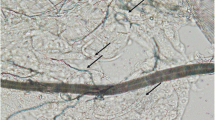Abstract
Psoroptes ovis mites were removed from infected sheep and placed in positions where wool and mites normally accumulate during sheep scab outbreaks. The ambient temperature and humidity were monitored over a 3-week period and the survival and infectivity times were examined. The procedure was carried out during each of the seasons. The hatchability of mite eggs was also examined. It was found that little variation occurred between seasons, with mites regularly retaining viability and infectivity for 15 days during all seasons. Mites that survived for more than 16 days failed to infect sheep. Mite eggs retained hatchability for up to 7 days.
Similar content being viewed by others
References
Babcock, O.G. and Black, W.L., 1933. The common sheep scab mite and its control.Texas Agricultural Experiment Station Bulletin,479, 1–34
Bedford, G.A.H., 1915.Third and Fourth Reports of the Director of Veterinary Research, Department of Agriculture, Union of South Africa, 1–99
Dill, R., 1920. Facts about ‘scab’ in sheep.National Woolgrower,10, 16
Du Toit, P.J., 1924. Sheep scab: The infectivity of kraals.Report of Director of Veterinary Research, Union of South Africa,9 & 10, 223–229
Hertwig, C.H., 1835. Some studies on the survival time of the sheep scab mite under different ambient conditions.Magazin des Gesellschaft fur Tierheilkunde,1, 137–164
Kirkwood, A.C., 1986. History, biology and control of sheep scab.Parasitology Today,2, 302–306
Liebisch, A., Olbrich, S. and Deppe, M., 1985. Survival ofP. ovis, P. cuniculi andC. bovis when separated from the host animal.Deutsche Tierarztliche Wochenschrift,92, 165–204
Nosek, J., 1978. The effects of micro-climate onIxodes ricinis. World Meteorological Organisation Technical Note No. 159, 105–116
O'Nuallain, T., 1966. Psoroptic acariasis or sheep scab; a review.Irish Veterinary Journal,20, 187–193
Riner, J.C. and Wright, F.C., 1981. A thermal plate apparatus for collecting live psoroptic mites.South Western Entomologist,6, 62–64
Salmon, D.E. and Stiles, C.H., 1903. Scab in sheep.United States Department of Agriculture Farmers Bulletin,159, 7–47
Shilston, A.W., 1915. Sheep scab. Observations on the life history ofPsoroptes communis varovis and some points connected with epizooiology of the disease in South Africa.Third and Fourth Reports of the Director Veterinary Research, Department of Agriculture, Union South Africa, 69–98
Stockman, S., 1912. Experimental work on sheep scab. Report of Protocol under Disease Animals Act. London 1911.The Veterinary News, August, 405–409
Tarry, D.W., 1974. Sheep scab, its diagnosis and biology.Veterinary Record,95, 530–532
Tarry, D.W., 1978. Weather andf arthropod ectoparasites.World Meteorological Organisation Technical Note No. 159, 143–150
Wilson, G.I., Blachut, K. and Roberts, I.H., 1977. The infectivity of scabies (mange) mitesP. ovis to sheep in naturally contaminated enclosures.Research in Veterinary Science,22, 292–297
Author information
Authors and Affiliations
Rights and permissions
About this article
Cite this article
O'Brien, D.J., Gray, J.S. & O'Reilly, P.F. Survival and retention of infectivity of the mitePsoroptes ovis off the host. Vet Res Commun 18, 27–36 (1994). https://doi.org/10.1007/BF01839258
Accepted:
Issue Date:
DOI: https://doi.org/10.1007/BF01839258



